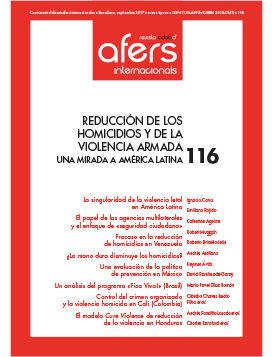Introduction: the singularity of lethal violence in Latin America
Keywords:
homicides, Latin America, prevention, lethal violenceAbstract
Revista CIDOB d’Afers Internacionals, nº 116
Quadrimestral (May-September 2017)
ISSN:1133-6595 | E-ISSN:2013-035X
DOI: https://doi.org/10.24241/rcai.2017.116.2.7
Latin America’s homicides reveal a dramatic scenario: not only because it is the region with the highest incidence of homicides in the world, but also because the negative developments of recent years mean the gap with other continents continues to grow. The singularity of this “Latin American problem” also influences the profiles of the victims, and the means and the motives of the violence, which differ to some degree from other regions. This article seeks to provide an overview of the region’s homicides and presents the main explanatory models used to explain this phenomenon, as well as the policies implemented to prevent it over recent years. Finally, the article introduces this monographic issue and provides a summary for each article contained within it, hoping to make a contribution to fostering reflection on the lethal violence in Latin America and the participation of all sectors in the search for solutions.
>> The full text articles of this issue are available only in Spanish language
References
Briceño, Roberto; Villaveces, Andrés y Concha-Eastman, Alberto. «Understanding the uneven distribution of the incidence of homicide in Latin America». International Journal of Epidemiology, vol. 37, n.º 4 (2008), p. 751-757.
Cano, Ignacio y Ferreira, Carlos Eugênio. «Homicídios e evolução demográfica no Brasil: o impacto da evolução demográfica na futura taxa de homicídios e a incidência dos homicídios na pirâmide populacional», en: Hansenbalg, Carlos y Silva, Nelson do Valle (org.). Origens e Destinos. Desigualdades sociais ao longo da vida. Río de Janeiro: Topbooks, 2004, p. 281-358.
Cano, Ignacio y Rojido, Emiliano. Mapeo de Programas de Prevención de Homicidios en América Latina y el Caribe [Informe final]. Río de Janeiro: Laboratório de Análise da Violência, Fórum Brasileiro de Segurança Pública, 2016.
Cruz, José Miguel (coord.). La violencia en El Salvador en los años noventa. Magnitud, costos y factores posibilitadores. Documento de Trabajo (R-338) de la Universidad Centroamericana José Simeón Cañas presentado al Banco Interamericano de Desarrollo. San Salvador: BID, 1998 (en línea) http://www.iadb.org/res/laresnetwork/files/pr38finaldraft.pdf
De Santis Feltran, Gabriel. «Governo que produz crime, crime que produz governo: o dispositivo de gestão do homicídio em São Paulo (1992-2011)». Rev. Bras. Segur. Pública, vol. 6, n.º 2 (2012), p. 232-255.
Dias Nunes, Camila. Da pulverização ao monopólio da violência: expansão e consolidação do Primeiro Comando da Capital (PCC) no sistema carcerário paulista. Tesis de doctorado en Sociología, Universidade de São Paulo, 2011.
Duailibi, Sergio; Ponicki, William; Grube, Joel; Pinsky, Ileana; Laranjeira, Ronaldo y Raw, Martin. «The effect of restricting opening hours on AlcoholRelated Violence». American Journal of Public Health, vol. 97, n.º 12 (2007), p. 2.276-2.280.
Eisner, Manuel. «From swords to words: Does macro-level change in self-control predict long-term variation in levels of homicide?». Crime and Justice, vol. 43, n.º 1 (2014), p. 65-134.
Fajnzylber, Pablo; Lederman, Daniel y Loayza, Norman. Determinants of Crime Rates in Latin America and the World: an empirical assessment. World Bank Latin American and Caribbean Studies. Washington, D. C.: World Bank, 1998.
Fox, Sean y Hoelscher, Kristian. «Political order, development and social violence». Journal of Peace Research, vol. 49, n.º 3 (2012), p. 431-444.
García, María Alejandra. Planificación urbana y seguridad ciudadana. Impacto de la creación de espacios públicos en la violencia. Caracas: Instituto Latinoamericano de Investigaciones Sociales, 2012.
Jaitman, Laura. «Introducción: los costos del crimen en el bienestar», en: Jaitman, Laura (ed.). Los Costos del Crimen y la Violencia en el Bienestar en América Latina y el Caribe. Washington D.C.: BID, 2016, p. 1-16.
Kahn, Tulio y Zanetti, André. «O Papel dos Municípios na Segurança Pública». Estudos Criminológicos, n.º 4 (junio de 2005).
Levitt, Steven. «Understanding why crime fell in the 1990s: Four factors that explain the decline and six that do not». Journal of Economic Perpectives, vol. 18, n.º 1 (2004), p. 163-190.
OMS-Organización Mundial de la Salud. «67ª Asamblea Mundial de la Salud. Resoluciones y decisiones». OMS, Ginebra (19 al 24 de mayo de 2014) (en línea) http://apps.who.int/gb/ebwha/pdf_files/WHA67-REC1/A67_2014_REC1-sp.pdf
PNUD-Programa de Naciones Unidas para el Desarrollo. Informe Regional de Desarrollo Humano 2013-2014. Seguridad ciudadana con rostro humano: diagnóstico y propuestas para América Latina. Nueva York: PNUD, 2013.
Ribeiro, Eduardo y Cano, Ignacio. «Vitimização letal e desigualdade no Brasil. Evidências em nível municipal». Revista Civitas, Porto Alegre, vol. 16, n.º 2 (2016), p. 285-305.
Rivera, Mauricio. «The sources of social violence in Latin America: An empirical analysis of homicide rates, 1980-2010». Journal of Peace Research, vol. 53, n.º 1 (2016), p. 84-99.
UNODC-United Nations Office on Drugs and Crime. Global Study on Homicide 2013. Trends, context, data. Viena: UNODC, 2014.
Villaveces, Andres; Cummings, Peter; Espitia, Victoria; Koepsell, Thomas; McKnight, Barbara y Kellermann, Arthur. «Effect of a Ban on Carrying Firearms on Homicide Rates in 2 Colombian Cities». JAMA, vol. 283, n.º 9 (2000), p. 1.205-1.209.
Weiselfsz, Julio Jacobo. Mapa da Violência 2016. Homicídios por arma de fogo no Brasil. Brasil: Flacso Brasil, 2016.












